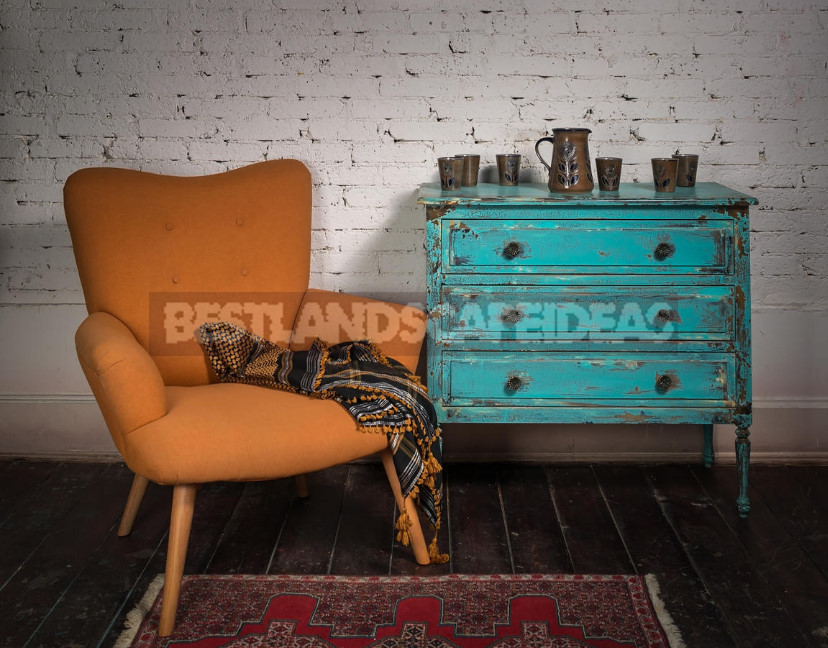
Such a strange thing turns out-we age by staining. Indeed, one of the options to update or redo old or just boring furniture — with the help of decorative techniques visually add her years, that is, to grow old. Traces of time on our faces we try to hide, but the furniture, on the contrary, age gives a certain charm.
Things with history “make” the interior, bringing a zest and uniqueness to it. If you do not have old chests of drawers — it does not matter, you can always add years of age unencumbered subject. Let’s talk about ways to age furniture.
The color “antique”
One of the options is painting “antique”. To understand how to do this, imagine what it looks like an old wardrobe, chest of drawers or cupboard, previously painted.

Approximately as in the photo above: over time, a layer of paint in some places peeled off, wiped and cracked.
Attritions
Inspect the item being updated carefully. Where will the paint be erased the most? Where it has the main load, in places where the object is most touched by hands or it is more often subjected to friction: at the corners and edges, on the protruding relief of the thread, near the handles. If there is a horizontal surface (table top), it will be rubbed where the person leans on it, sitting at a table or working.
Determining the place of future “scuffs”, you can start their creation. But first you need to perform the preparatory work. To create decorative scuffs need at least 2 shades: the color of the base and the top layer.

The choice of color combinations opens a wide field for experiments. The most traditional solution — “dark bottom, light top”: the base is made darker, and for the surface layer using shades of white, cream, pastel colors. But this is not the rule, choose shades to your liking.
If the furniture is made of real wood, the dark wood texture can become the color of the base, then you only need to choose the color of paint for finishing. By the way, dark lacquered furniture of the Soviet era is quite suitable as a base. You only need to remove the lacquer gloss to improve adhesion. If the furniture is not wooden, you have added it is not wooden parts or its natural color does not fit your idea, first paint the furniture in the color of the base.

To speed up the aging process, it is necessary that the paint in the places of the planned scuffs does not stick well. Most often used for this coating of wax or paraffin. You can simply RUB the candle selected places or melt the paraffin and apply it with a brush.
Now it’s time to cover the finish layer of paint. Once it is completely dry, use a cloth to remove it in places covered with wax: poorly adhered because of the wax coating, it will open the bottom color.
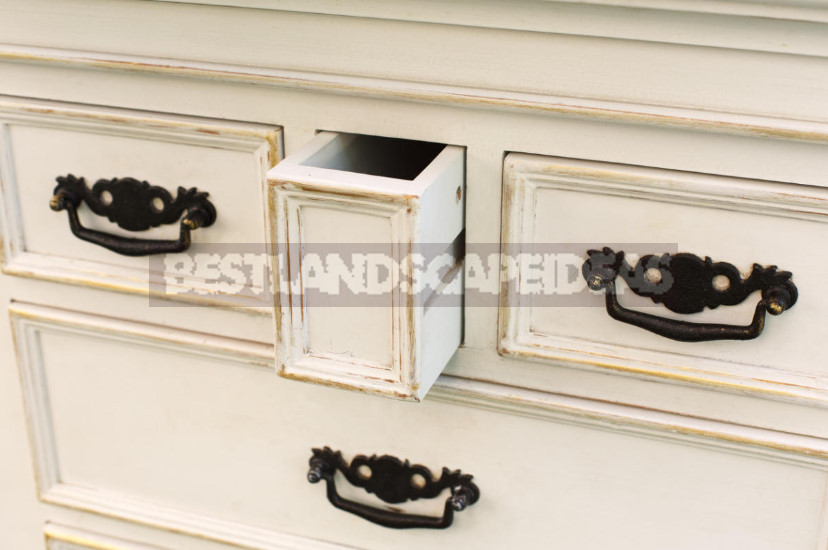
A more time — consuming option is a multi-layer coating. This is an imitation of a very old thing, repeatedly repainted. The technology is the same: paint in the base color, apply wax, paint the second layer of a different color, again apply the wax in the right places and cover with another layer — again a different color. After drying, remove excess paint.
Decorative abrasions on the furniture can be done without wax. Toning wood with stain, and then paint. After drying the paint, take the abrasive skin and remove the excess — treat the painted surface to achieve the desired result.
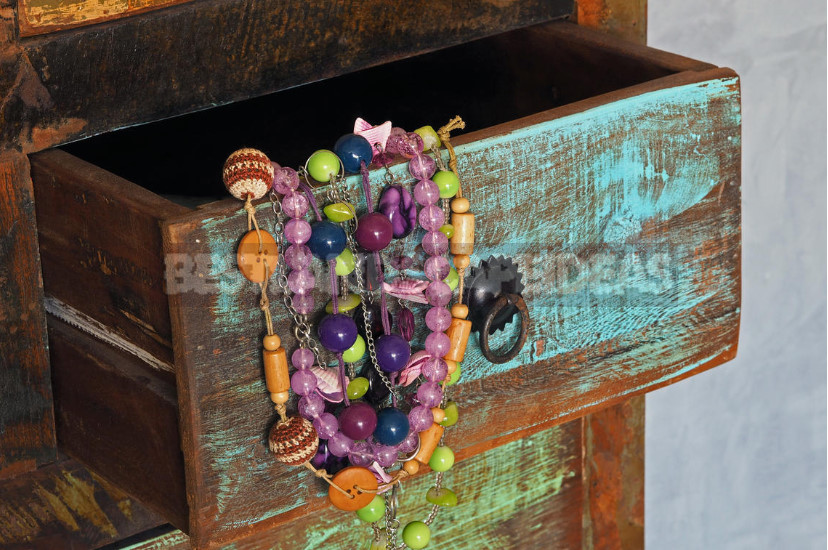
After grinding the surface should be covered with a transparent varnish for fixing, because the paint layer is broken abrasive. Please note: stain and paint should have the same composition. For example, for water-based paints, choose a water stain.
Decorative “pollution”
Another way to add years of paint to a table or chair is to imitate old dirt. It is no secret that from the long-term use on the surface accumulate dirt. Traces of “long operation” can be drawn in two ways.
- Glazing coatings
We use translucent paints or varnishes, they are also called lazuli, glazes. They are applied to a pre-painted surface, and then partially erased with a cloth or sponge, without waiting for drying.

The azure will remain in the recesses, emphasizing irregularities. The most impressive such a coating looks on the reliefs or textured surface.
Combinations of base paint and glaze can be infinitely varied. Translucent coatings come in different colors, as well as pearl or metallic shades. Or, on the contrary, you can paint the object with paint that mimics bronze, gold, copper or silver and use a dark shade of the eye. The result is a surface of “old bronze”, “patinated copper” or “scarlet silver” (depending on the color of the base).
- Dry brush painting
If the surface of the converted furniture does not differ in special relief, use the method of painting “dry brush”. First, paint the object with a base shade of paint, and after it dries, apply the second — decorative.

Take a brush, dip in the paint, and then remove the excess part — wipe the brush on paper or cloth until it becomes almost dry. Now we apply it tint strokes in those places where dirt accumulates in natural conditions — in the recesses, seams. Make sure that the smears were natural-in the direction of wood fibers.
In this way, you can simulate and scuffs. Only in this case tint strokes-highlights, on the contrary, are applied to the protruding parts — where more rubs.
Tinted stain
This method is more suitable not for the alteration of old furniture, and for painting “antique” new. Stain is applied to the surface of the tree, and then, until the coating is dry, the excess is erased with a rag.
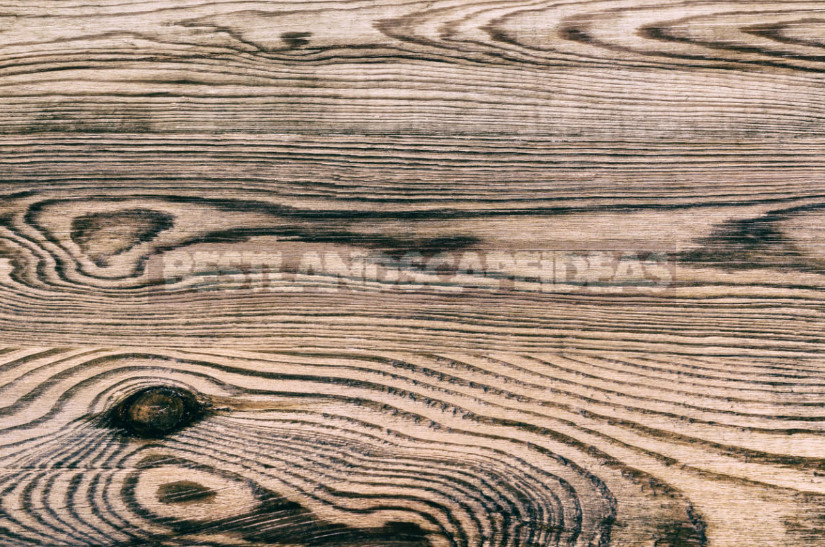
Softer areas of wood will absorb the coloring composition, and it will be erased from the dense ones. The operation can be repeated if the result does not satisfy. Try to use stains of different shades, only before covering the finished product experiment on an unnecessary piece of wood or where it will not be visible.
After the treated surface is dry, you can further cover the furniture with a pearlescent glaze coating. Well and treat with clear varnish to protect the decorative layer.
The methods of artificial aging with the help of paint also include craquelure and gilding. And the surface of wooden furniture can be aged by brushing and firing.


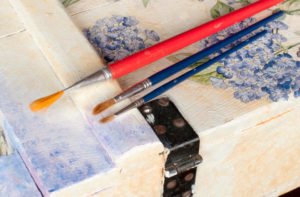
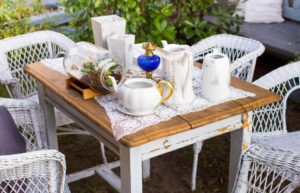
Leave a Reply